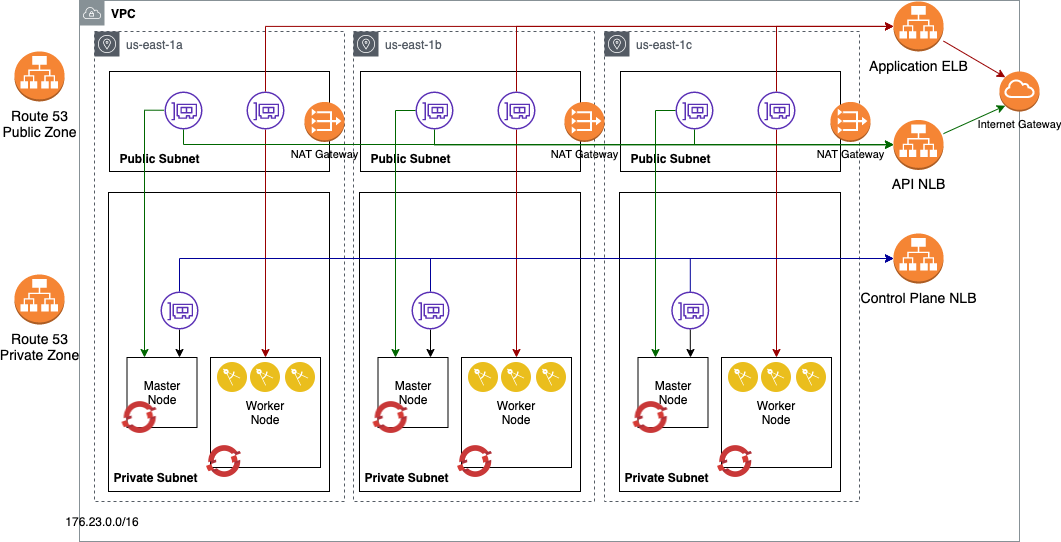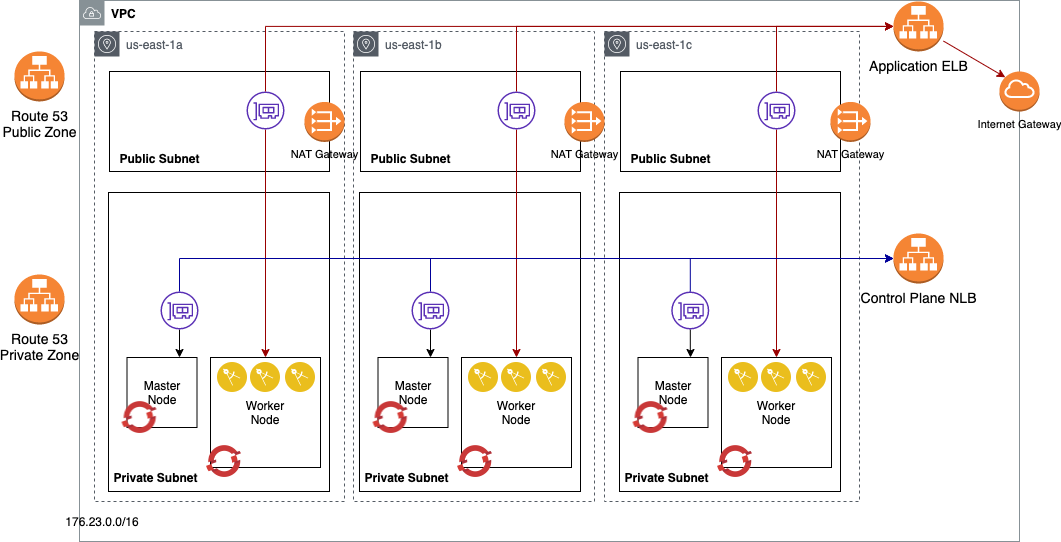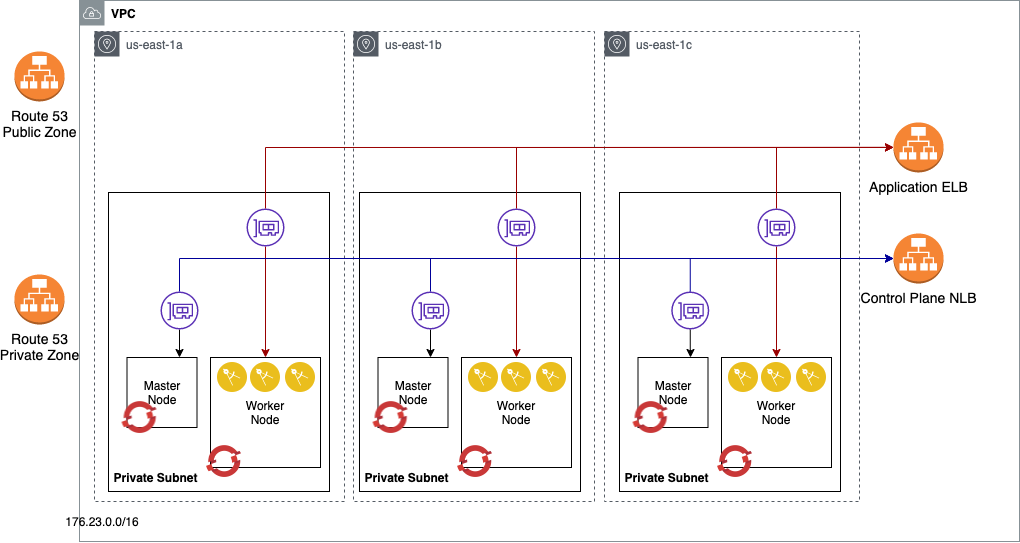This project automates the Red Hat OpenShift Container Platform 4.6 (for previous releases - checkout pre46 branch) installation on Amazon AWS platform. It focuses on the OpenShift User-provided infrastructure installation (UPI) where implementers provide pre-existing infrastructure including VMs, networking, load balancers, DNS configuration etc.
- Terraform Automation
- Infrastructure Architecture
- Installation Procedure
- Airgapped installation
- Removal procedure
- Advanced topics
This project uses mainly Terraform as infrastructure management and installation automation driver. All the user provisioned resource are created via the terraform scripts in this project.
-
To use Terraform automation, download the Terraform binaries here. The code here supports Terraform 0.15 or later.
On MacOS, you can acquire it using homebrew using this command:
brew install terraform
-
Install git
sudo yum intall git-all git --version
-
Install wget command:
- MacOS:
brew install wget - Linux: (choose the command depending on your distribution)
apt-get install wget yum install wget zypper install wget
- MacOS:
-
Get the Terraform code
git clone https://github.com/ibm-cloud-architecture/terraform-openshift4-aws.git
-
Prepare the DNS
OpenShift requires a valid public Route53 hosted zone. (Even if you plan to use an airgapped environment)
-
Prepare AWS Account Access
Please reference the Required AWS Infrastructure components to setup your AWS account before installing OpenShift 4.
We suggest to create an AWS IAM user dedicated for OpenShift installation with permissions documented above. On the bastion host, configure your AWS user credential as environment variables:
export AWS_ACCESS_KEY_ID=RKXXXXXXXXXXXXXXX export AWS_SECRET_ACCESS_KEY=LXXXXXXXXXXXXXXXXXX/ng export AWS_DEFAULT_REGION=us-east-2
For detail on OpenShift UPI, please reference the following:
The terraform code in this repository supports 3 installation modes:
There are other installation modes that are possible with this terraform set, but we have not tested all the possible combinations, see Advanced usage
This project installs the OpenShift 4 in several stages where each stage automates the provisioning of different components from infrastructure to OpenShift installation. The design is to provide the flexibility of different topology and infrastructure requirement.
-
The deployment assumes that you run the terraform deployment from a Linux based environment. This can be performed on an AWS-linux EC2 instance. The deployment machine has the following requirements:
- git cli
- terraform 0.15 or later
- wget command
- jq command
-
Deploy the OpenShift 4 cluster using the following modules in the folders:
- route53: generate a private hosted zone using route 53
- install: Build the installation files, ignition configs and modify YAML files
-
vpc: Create the VPC, subnets, security groups and load balancers for the OpenShift cluster
- iam: define AWS authorities for the masters and workers
- bootstrap: main module to provision the bootstrap node and generates OpenShift installation files and resources
- master: create master nodes manually (UPI)
You can also provision all the components in a single terraform main module, to do that, you need to use a terraform.tfvars, that is copied from the terraform.tfvars.example file. The variables related to that are:
Create a
terraform.tfvarsfile with following content:
cluster_name = "ocp4"
base_domain = "example.com"
openshift_pull_secret = "./openshift_pull_secret.json"
openshift_version = "4.6.28"
aws_extra_tags = {
"owner" = "admin"
}
aws_region = "us-east-1"
aws_publish_strategy = "External"
| name | required | description and value |
|---|---|---|
cluster_name |
yes | The name of the OpenShift cluster you will install |
base_domain |
yes | The domain that has been created in Route53 public hosted zone |
openshift_pull_secret |
no | The value refers to a file name that contain downloaded pull secret from https://cloud.redhat.com/openshift/pull-secret; the default name is openshift_pull_secret.json |
openshift_version |
yes | The openshift version to be installed. |
aws_region |
yes | AWS region that the VPC will be created in. By default, uses us-east-2. Note that for an HA installation, the AWS selected region should have at least 3 availability zones. |
aws_extra_tags |
no | AWS tag to identify a resource for example owner:myname |
aws_azs |
no | list of availability zones to deploy VMs - default to the [a, b, c] |
openshift_byo_dns |
no | whether to ignore DNS resources (you still need a public zone defined) |
openshift_ssh_key |
no | whether to use a specific public key |
openshift_additional_trust_bundle |
no | additional trust bundle for accessing resources - ie proxy or repo |
aws_publish_strategy |
no | Whether to publish the API endpoint externally - Default: "External" |
airgapped |
no | A map with enabled (true/false) and repository name - This must be used with aws_publish_strategy of Internal |
proxy_config |
no | To be implemented |
use_ipv4 |
no | To be implemented |
use_ipv6 |
no | To be implemented |
See Terraform documentation for the format of this file.
Initialize the Terraform:
terraform initRun the terraform provisioning:
terraform plan
terraform applyOnce the cluster is installed, the bootstrap node is no longer used at all. One of the indication that the bootstrap has been completed is that the API load balancer target group shows that the bootstrap address is unhealthy.
terraform destroy -target=module.bootstrap.aws_instance.bootstrap
For performing a completely airgapped cluster, there are two capabilities that would not be available from the cluster's automation capabilities, the IAM and Route53 management access. The airgapped solution can address this by pre-creating the roles and secret that are needed for OpenShift to complete its functions, but the DNS update on Route53 must be performed manually after the installation.
Setting up the mirror repository using AWS ECR:
-
Create the repository
aws ecr create-repository --repository-name ocp435 -
Prepare your credential to access the ECR repository (ie the credential only valid for 12 hrs)
aws ecr get-loginExtract the password token (
-pargument) and create a Base64 string:echo "AWS:<token>" | base64 -w0Put that into your pull secret:
{"353456611220.dkr.ecr.us-east-1.amazonaws.com":{"auth":"<base64string>","email":"abc@example.com"}} -
Mirror quay.io and other OpenShift source into your repository
export OCP_RELEASE="4.6.28-x86_64" export LOCAL_REGISTRY='1234567812345678.dkr.ecr.us-east-1.amazonaws.com' export LOCAL_REPOSITORY='ocp46' export PRODUCT_REPO='openshift-release-dev' export LOCAL_SECRET_JSON='/home/ec2-user/openshift_pull_secret.json' export RELEASE_NAME="ocp-release" oc adm -a ${LOCAL_SECRET_JSON} release mirror --max-per-registry=1 \ --from=quay.io/${PRODUCT_REPO}/${RELEASE_NAME}:${OCP_RELEASE} \ --to=${LOCAL_REGISTRY}/${LOCAL_REPOSITORY} \ --to-release-image=${LOCAL_REGISTRY}/${LOCAL_REPOSITORY}:${OCP_RELEASE} -
Provide the certificate(s) for the registry in a file and refers that from the vars to be included in the
install-config.yaml.
Once the mirror registry is created - use the terraform.tfvars similar to below:
cluster_name = "ocp4"
base_domain = "example.com"
openshift_pull_secret = "./openshift_pull_secret.json"
openshift_installer_url = "https://mirror.openshift.com/pub/openshift-v4/clients/ocp/4.6.28"
aws_access_key_id = "AAAA"
aws_secret_access_key = "AbcDefGhiJkl"
aws_ami = "ami-06f85a7940faa3217"
aws_extra_tags = {
"owner" = "admin"
}
aws_azs = [
"us-east-1a",
"us-east-1b",
"us-east-1c"
]
aws_region = "us-east-1"
aws_publish_strategy = "Internal"
airgapped = {
enabled = true
repository = "1234567812345678.dkr.ecr.us-east-1.amazonaws.com/ocp435"
cabundle = "./cabundle"
}
Note: To use airgapped.enabled of true must be done with aws_publish_strategy of Internal otherwise the deployment will fail. Also ECR does not allow for unauthenticated image pulls, additional IAM policies must be defined and attached to the nodes to be able to pull from ECR.
Create your cluster and then associate the private Hosted Zone Record in Route53 with the loadbalancer for the *.apps.<cluster>.<domain>.
To delete the cluster - terraform destroy can be implemented.
The following items are not deleted (and may stop destroy from being successful):
- EBS volumes from the gp2 storage classes
- Public zone DNS updates
- Custom compute nodes that are not the initial worker nodes
Additional configurations and customization of the implementation can be performed by changing some of the default variables. You can check the variable contents in the following terraform files:
- variable-aws.tf: AWS related customization, such as machine sizes and network changes
- config.tf: common installation variables for installation (not cloud platform specific)
Note: Not all possible combinations of options has been tested - use them at your own risk.


